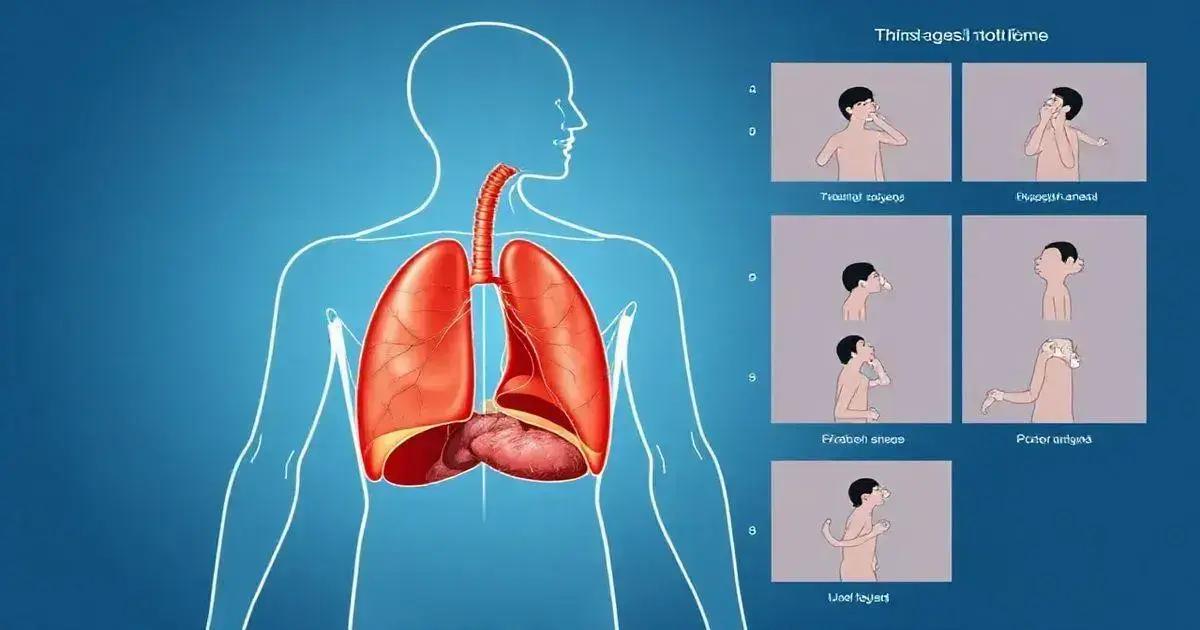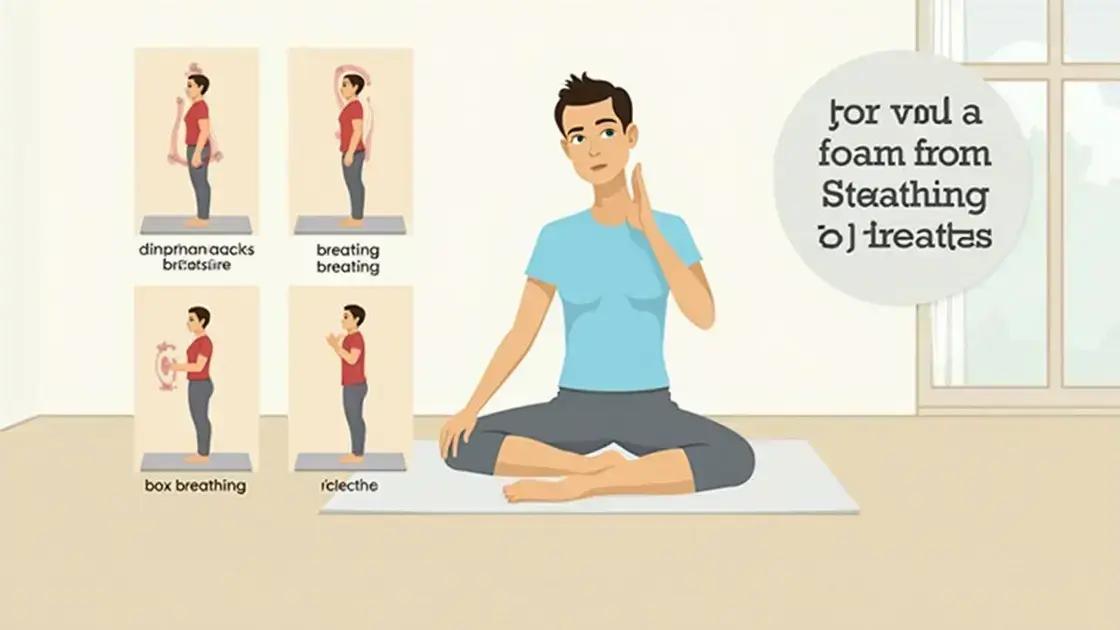Breathing exercises are essential for maintaining healthy lungs, as they improve lung capacity, enhance oxygen flow, and reduce stress. Techniques like diaphragmatic breathing, box breathing, and pursed-lip breathing can be easily incorporated into daily routines. Regular practice leads to better respiratory function and overall well-being.
Maintaining healthy lungs is vital for overall well-being, and incorporating effective breathing exercises can significantly enhance lung function. These exercises are designed to increase lung capacity, improve oxygen flow, and promote relaxation. In this article, we will explore the importance of lung health, the science behind breathing exercises, and practical techniques you can easily include in your daily routine. Your journey to better lung health starts here!
Understanding Lung Health and Its Importance

Understanding lung health is crucial for maintaining overall wellness. Our lungs play a vital role in breathing, which provides the oxygen our body needs to function properly. When we breathe in, air travels through the trachea and into the bronchi, leading to smaller branches called bronchioles, and finally to tiny air sacs known as alveoli.
In these alveoli, oxygen is exchanged for carbon dioxide. This process is essential for our survival, and healthy lung function enhances our quality of life. Therefore, keeping lungs healthy reduces the risk of respiratory diseases and contributes to better physical performance.
The Importance of Lung Health
Adequate lung function supports various bodily systems. For instance, it improves oxygen delivery to the bloodstream, ensuring our vital organs receive the nourishment they need. This can enhance energy levels and mental clarity.
Furthermore, healthy lungs help the body manage toxins and allergens. They filter out harmful substances, making it easier for us to breathe clean air. When lung health declines, these processes can become compromised, leading to conditions like asthma, chronic obstructive pulmonary disease (COPD), and other serious illnesses.
Maintaining Lung Health
To maintain lung health, it’s important to avoid smoking and exposure to pollutants. Regular exercise is also key, as it encourages good lung function and strengthens respiratory muscles. Staying hydrated helps to thin mucus in the airways, allowing for easier breathing. Breathing exercises are particularly effective; they can improve lung capacity and efficiency.
In sum, understanding and prioritizing lung health is essential for everyone. Incorporating healthy habits into daily life, including breathing exercises, can make a significant difference in our respiratory health.
The Science Behind Breathing Exercises

The science behind breathing exercises reveals how these techniques benefit lung function and overall health. Breathing is not just a subconscious act; it can be controlled and manipulated to enhance our physical and mental state. When we engage in breathing exercises, we consciously regulate our breath to optimize oxygen intake and carbon dioxide release.
Breathing exercises can improve lung capacity by encouraging deeper and more effective breaths. This process involves utilizing the diaphragm, the primary muscle responsible for breathing. By engaging the diaphragm, we can draw in more air, allowing better oxygen exchange in the alveoli, the tiny air sacs in the lungs.
Physiological Effects of Breathing Exercises
Engaging in these exercises can also lower stress levels. Slow, controlled breathing activates the parasympathetic nervous system, which promotes a state of calm and relaxation. This is particularly beneficial for those dealing with anxiety or high stress. Similarly, practicing deep breathing can help lower blood pressure and improve heart function, essential components of cardiovascular health.
Furthermore, breathing exercises can enhance brain function. They increase oxygen flow to the brain, which may improve cognitive performance and concentration. Studies suggest that consistent practice can lead to improved memory and potentially support mental clarity.
Types of Breathing Techniques
Different techniques exist, including diaphragmatic breathing, box breathing, and pursed-lip breathing, each offering unique benefits. Diaphragmatic breathing emphasizes deep breaths that fill the lungs completely. Box breathing involves four-count inhales, holds, and exhales, which can help boost focus and reduce anxiety. Pursed-lip breathing encourages long, slow breaths, making it particularly effective for those with respiratory conditions.
In essence, understanding the science behind these exercises highlights their significant impact on health. By incorporating various techniques, individuals can enhance their respiratory efficiency and overall well-being.
Top Breathing Exercises for Lung Health

Top breathing exercises for lung health can significantly improve your respiratory function and overall well-being. Incorporating these techniques into your routine will help maintain clear airways and enhance lung efficiency. Here are some effective exercises to consider:
1. Diaphragmatic Breathing
This exercise focuses on using your diaphragm to breathe deeply. Here’s how to do it:
- Lie down or sit comfortably.
- Place one hand on your chest and the other on your stomach.
- Breathe in slowly through your nose, ensuring that your stomach rises while your chest stays still. Count to four.
- Hold your breath for a count of four.
- Exhale slowly through your mouth, feeling your stomach fall. Count to four.
Repeat this for 5-10 minutes daily to strengthen your diaphragm.
2. Box Breathing
This technique uses a pattern of inhaling, holding, exhaling, and pausing. Here’s the process:
- Breathe in through your nose for a count of four.
- Hold your breath for a count of four.
- Exhale through your mouth for a count of four.
- Pause and hold your breath for another count of four.
Repeat this cycle for several minutes. Box breathing can help reduce stress and improve focus.
3. Pursed-Lip Breathing
This technique helps to keep your airways open longer, enhancing your lung function:
- Breathe in slowly through your nose for a count of two.
- Purse your lips as if you were going to whistle.
- Exhale slowly and gently through your pursed lips for a count of four.
This method is particularly beneficial during physical activity or when you feel short of breath.
4. Deep Breathing with Arm Raises
This exercise combines deep breathing with gentle movement:
- Stand or sit comfortably.
- Inhale deeply as you raise your arms above your head.
- Hold your breath for a moment.
- Exhale slowly as you lower your arms to your sides.
Repeat this several times, feeling your lungs expand and contract.
Practicing these breathing exercises regularly can help improve your lung health, increase oxygen flow, and reduce stress. Incorporate them into your daily routine to enjoy their benefits.
Tips for Incorporating Breathing Exercises Into Daily Life

Tips for incorporating breathing exercises into daily life can help you make these practices a regular part of your routine. Doing so can enhance your lung health and overall well-being. Here are practical suggestions to get started:
1. Set a Regular Schedule
Consistency is key. Designate a specific time each day for your breathing exercises, such as early in the morning or before bedtime. This helps establish a habit. Start with just a few minutes and gradually increase the duration as you become more comfortable.
2. Use Reminders
Set alarms or reminders on your phone to prompt you to practice your breathing exercises. Visual cues, like sticky notes in prominent places, can also serve as reminders. Making it a part of your daily schedule will help you remember.
3. Combine with Other Activities
Incorporate breathing exercises into other daily routines. For example, practice deep breathing while waiting in line, during your commute, or while watching TV. This makes the practice easier to maintain without needing extra time.
4. Create a Calm Environment
Find a quiet, relaxing space where you can perform your exercises. This can be a corner of a room, a garden, or even a peaceful park. Setting the right atmosphere can enhance your focus and improve your practice.
5. Involve Friends or Family
Invite family members or friends to join you. Practicing together can be motivating and provide support. You can even make it a fun group activity, discussing your experiences and progress.
6. Track Your Progress
Keeping a journal or using an app to track your breathing exercises can motivate you. Noting your thoughts and experiences can help you see improvements over time and keep you engaged in the practice.
7. Start Small
Don’t feel pressured to do extended sessions right away. Start with just a few minutes each day and gradually increase the duration as you grow more comfortable with the exercises.
By following these tips, you can easily integrate breathing exercises into your daily life. Doing so will enhance your lung health while promoting relaxation and reducing stress.
In Summary: The Importance of Breathing Exercises for Lung Health
Breathing exercises play a vital role in maintaining healthy lungs and enhancing overall well-being. By understanding lung health and its importance, you can appreciate the profound impact these techniques have on your respiratory system.
The science supports the effectiveness of breathing exercises, showing how they can improve lung function, reduce stress, and enhance cognitive performance. Incorporating a variety of exercises into your daily routine allows you to reap these benefits while promoting relaxation and mindfulness.
Adopting practical tips for including breathing exercises in your life helps make the practice sustainable. Remember to set a regular schedule, use reminders, and involve friends or family to keep you motivated.
By prioritizing these exercises, you not only improve your lung health but also cultivate a greater sense of tranquility and resilience in today’s fast-paced world.
FAQ – Frequently Asked Questions about Breathing Exercises for Lung Health
How can breathing exercises improve my lung health?
Breathing exercises can enhance lung function by expanding lung capacity, increasing oxygen flow, and reducing stress, which contributes to overall health.
What are some effective breathing exercises?
Effective breathing exercises include diaphragmatic breathing, box breathing, pursed-lip breathing, and deep breathing with arm raises.
How often should I practice breathing exercises?
It’s beneficial to practice breathing exercises daily, starting with just a few minutes and gradually increasing the duration as you get more comfortable.
Can I incorporate breathing exercises into my daily routine?
Yes, you can integrate breathing exercises into your daily life by setting reminders, combining them with other activities, or making them a part of your morning or nighttime routine.
Do I need any special equipment for breathing exercises?
No special equipment is needed. Just find a quiet space where you can focus and practice the exercises comfortably.
Are breathing exercises suitable for everyone?
Yes, breathing exercises are generally safe for most people. However, if you have pre-existing respiratory conditions, it’s best to consult a healthcare professional before starting any new exercise program.













